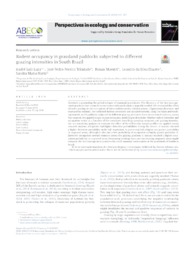Rodent occupancy in grassland paddocks subjected to different grazing intensities in South Brazil.
Rodent occupancy in grassland paddocks subjected to different grazing intensities in South Brazil.
Autoria: LUZA, A. L.; TRINDADE, J. P. P.; MAESTRI, R.; DUARTE, L. da S.; HARTZ, S. M.
Resumo: tLivestock is promoting the global collapse of mammal populations. The discovery of the best manage-ment practices that reconcile conservation with production is urgently needed. We evaluated the effectof cattle grazing on the occupation of three rodent species (Akodon azarae, Oligoryzomys flavescens andOxymycterus nasutus). We collected habitat covariates and sampled rodents, using live traps and track-ing tunnels, in 20 paddocks subjected to different grazing pressures, from two research stations, acrossfour seasons. We applied single-season occupancy modeling to determine whether rodent detection andoccupation varied as a function of the covariates describing sampling occasions and grazing intensity.We ran sensitivity analyses to evaluate the effect of the differential sampling effort we applied acrossresearch stations. All species had higher detection probabilities during the winter. O. nasutus showeda higher detection probability under tall vegetation. A. azarae reached a higher occupation probabilityin ungrazed areas, although it also had a low probability of occupation in highly grazed paddocks. O.flavescens occupation seemed constant across the grazing gradient. O. nasutus reached a higher occu-pation probability in ungrazed areas. Decreasing stocking rates and maintaining ungrazed areas mightcompose the best management practices for small mammal conservation in the grasslands of SouthernBrazil.
Ano de publicação: 2018
Tipo de publicação: Artigo de periódico
Unidade: Embrapa Pecuária Sul
Palavras-chave: Conservação, Mamífero, Pastagem, Roedor
Observações
1 - Por padrão são exibidas publicações dos últimos 20 anos. Para encontrar publicações mais antigas, configure o filtro ano de publicação, colocando o ano a partir do qual você deseja encontrar publicações. O filtro está na coluna da esquerda na busca acima.
2 - Para ler algumas publicações da Embrapa (apenas as que estão em formato ePub), é necessário ter, no celular ou computador, um desses softwares gratuitos. Sistemas Android: Google Play Livros; IOS: iBooks; Windows e Linux: software Calibre.
Acesse outras publicações
Acesse a Base de Dados da Pesquisa Agropecuária (BDPA) para consultar o acervo completo das bibliotecas da Embrapa.

